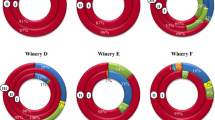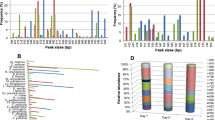Abstract
The evolution of the wine microbial ecosystem is generally restricted to Saccharomyces cerevisiae and Oenococcus oeni, which are the two main agents in the transformation of grape must into wine by acting during alcoholic and malolactic fermentation, respectively. But others species like the yeast Brettanomyces bruxellensis and certain ropy strains of Pediococcus parvulus can spoil the wine. The aim of this study was to address the composition of the system more precisely, identifying other components. The advantages of the polymerase chain reaction-denaturing gradient gel electrophoresis (PCR-DGGE) approach to wine microbial ecology studies are illustrated by bacteria and yeast species identification and their monitoring at each stage of wine production. After direct DNA extraction, PCR-DGGE was used to make the most exhaustive possible inventory of bacteria and yeast species found in a wine environment. Phylogenetic neighbor-joining trees were built to illustrate microbial diversity. PCR-DGGE was also combined with population enumeration in selective media to monitor microbial changes at all stages of production. Moreover, enrichment media helped to detect the appearance of spoilage species. The genetic diversity of the wine microbial community and its dynamics during winemaking were also described. Most importantly, our study provides a better understanding of the complexity and diversity of the wine microbial consortium at all stages of the winemaking process: on grape berries, in must during fermentation, and in wine during aging. On grapes, 52 different yeast species and 40 bacteria could be identified. The diversity was dramatically reduced during winemaking then during aging. Yeast and lactic acid bacteria were also isolated from very old vintages. B. bruxellensis and O. oeni were the most frequent.










Similar content being viewed by others
References
Amann R, Ludwig W (2000) Ribosomal RNA-targeted nucleic acid probes for studies in microbial ecology. FEMS Microbiol Rev 24:555–565
Ampe F, Sirvent A, Zakhia N (2001) Dynamics of the microbial community responsible for traditional sour cassava starch fermentation studied by denaturing gradient gel electrophoresis and quantitative rRNA hybridization. Int J Food Microbiol 65:45–54
Campos FM, Couto JA, Hogg TA (2003) Influence of phenolic acids on growth and inactivation of Oenococcus oeni and Lactobacillus hilgardii. J Appl Microbiol 94:167–174
Carpentier B, Cerf O (1993) Biofilms and their consequences, with particular reference to hygiene in the food industry. J Appl Bacteriol 75:499–511
Chatonnet P, Dubourdieu D, Boidron JN, Pons M (1992) The origin of ethyphenols in wines. J Sci Food Agric 60:165–178
Cocolin L, Bisson LF, Mills DA (2000) Direct profiling of the yeast dynamics in wine fermentations. FEMS Microbiol Lett 189:81–87
Coenye T, Vandamme P (2003) Intragenomic heterogeneity between multiple 16S ribosomal RNA operons in sequenced bacterial genomes. FEMS Microbiol Lett 228:45–49
Coton E, Coton M (2003) Microbiological origin of « framboisé » in French ciders. J Inst Brew 109:299–301
Coton E, Rollan GC, Bertrand A, Lonvaud-Funel A (1998) Histamine-producing lactic acid bacteria in wines: early detection, frequency and distribution. Am J Enol Vitic 49:19–23
Del Campo G, Santos JI, Berregi I, Velasco S, Ibarburu I, Duenas MT, Irastorza A (2003) Ciders produced by two types of presses and fermented in stainless steel and wooden vats. J Inst Brew 109:342–348
Dent KC, Stephen JR, Finch-Savage WE (2004) Molecular profiling of microbial communities associated with seeds of Beta vulgaris subsp. Vulgaris (sugar beet). J Microbiol Methods 56:17–26
Ercolini D, Hill PJ, Dodd CE (2003) Bacterial community structure and location in Stilton cheese. Appl Environ Microbiol 69:3540–3548
Felsentein J (1985) Confidence limits on phylogenies: an approach using the bootstrap. Evolution 39:783–791
Guillamon JM, Sabate J, Barrio E, Cano J, Querol A (1998) Rapid identification of wine yeast species based on RFLP analysis of the ribosomal ITS regions. Arch Microbiol 169:387–392
Kumar S, Tanura K, Jakobsen IB, Masatoshi N (2001) MEGA2: Molecular Evolutionary Genetics Analysis software, Arizona State University, Tempe, AZ USA
Kurtzman CP, Robnett CJ (1997) Identification of clinically important ascomycetous yeasts based on nucleotide divergence in the 5′ end of the large-subunit (26S) ribosomal DNA gene. J Clin Microbiol 35:1216–1223
Lambrechts MG, Pretorius IS (2000) Yeast and its importance to wine aroma—a review. S Afr J Enol Vitic 21:97–129
Le Jeune C, Lonvaud-Funel A (1994) Lactobacillus hilgardii and Lactobacillus brevis DNA analysis by restriction fragment length polymorphism. Food Microbiol 11:195–202
Lonvaud-Funel A, Joyeux A, Ledoux O (1991) Specific enumeration of lactic acid bacteria in fermenting grape must and wine by colony hybridization with non-isotopic DNA-probes. J Appl Microbiol 71:501–508
Lopez I, Ruiz-Larrea F, Cocolin L, Orr E, Phister T, Marshall M, Vanderghenst J, Mills DA (2003) Design and evaluation of PCR primers for analysis of bacterial populations in wine by denaturing gradient gel electrophoresis. Appl Environ Microbiol 69:6801–6807
Manachini PL, Parini C, Fortina MG (1988) Pectic enzymes from Aureobasidium pullulans LV 10. Enzyme Microb Technol 10:682–685
Miambi E, Guyot JP, Ampe F (2003) Identification, isolation and quantification of representative from fermented cassava dough using an integrated approach of culture-dependent and culture-independent methods. Int J Food Microbiol 82:111–120
Millet V, Lonvaud-Funel A (2000) The viable but non-culturable state of wine micro-organisms during storage. Lett Appl Microbiol 30:136–141
Mills DA, Johansen EA, Cocolin L (2002) Yeast diversity and persistence in Botrytis-affected wine fermentations. Appl Environ Microbiol 68:4884–4893
Muyzer G, de Waal EC, Uitterlinden AG (1993) Profiling of complex microbial populations by denaturing gradient gel electrophoresis analysis of polymerase chain reaction amplified genes coding for 16S rRNA. Appl Environ Microbiol 59:695–700
Prakitchaiwattana CJ, Flett GH, Heard GM (2004) Application and evaluation of denaturing gradient gel electrophoresis to analyze the yeast ecology of wine grapes. FEMS Yeast Res 4:865–877
Prem AA, Sriphati K (2004) Digestion of cellulose and xylan by symbiotic bacteria in the intestine of the Indian flying fox (Pteropus giganteus). Comp Biochem Physiol 139:65–69
Rantsiou K, Comi G, Cocolin L (2004) The rpoB gene as a target for PCR-DGGE analysis to follow lactic acid bacterial population dynamics during food fermentations. Food Microbiol 21:481–487
Renouf V, Lonvaud-Funel A (2005) Incidence microbiologique de l’usage de barriques neuves et/ou de barriques usagées. Rev Fr Oenol 211:10–14
Renouf V, Lonvaud-Funel A (2006) Development of an enrichment medium to detect Dekkera/Brettanomyces bruxellensis, a spoilage wine yeast, on the surface of grape berries. Microbiol Res (in press)
Renouf V, Claisse O, Lonvaud-Funel A (2005a) Numeration, identification and understanding of microbial biofilm on grape berry surface. Aust J Grape Wine Res 11:316–327
Renouf V, Claisse O, Lonvaud-Funel A (2005b) Use of the rpoB gene as a target for PCR-DGGE analysis to follow bacteria species evolution on the grape berry surface and during the red and white winemaking process. 8th Symposium on lactic acid bacteria. Amsterdam, The Netherlands, 25–28 June
Renouf V, Claisse O, Lonvaud-Funel A (2006a) rpoB gene: a target for identification of LAB cocci by PCR-DGGE and melting curves analyses in real time PCR. J Microbiol Methods 67:162–170
Renouf V, Claisse O, Miot-Sertier C, Lonvaud-Funel A (2006b) LAB evolution during winemaking use of rpoB gene as a target for PCR-DGGE analysis. Food Microbiol 23:36–145
Renouf V, Falcou M, Miot-Sertier C, Perello MC, de Revel G, Lonvaud-Funel A (2006c) Interactions between Brettanomyces bruxellensis and the other yeasts species during the first steps of winemaking. J Appl Microbiol 100:1208–1219
Saitou N, Nei M (1987) The neighbor-joining method: a new method for reconstructing phylogenetic trees. Mol Biol Evol 4:406–425
Sigler WV, Miniaci C, Zeyer J (2004) Electrophoresis time impacts the denaturing gradient gel electrophoresis-based assessment of bacterial community structure. J Microbiol Methods 57:17–22
Susuki MT, Giovannoni SJ (1996) Bias causes by template annealing in the amplification of mixtures of 16 rRNA genes by PCR. Appl Environ Microbiol 62:625–690
Swaffield CH, Scott JA (1995) Existence and development of natural microbial populations in wooden vats used for alcoholic cider maturation. J Am Soc Brew Chem 53:117–120
Swaffield CH, Scott JA, Jarvis B (1997) Observation on the microbial ecology of traditional alcoholic cider storage vats. Food Microbiol 14:353–361
Uscanga MGA, Delia ML, Strehaiano P (2000) Nutritional requirements of Brettanomyces bruxellensis: growth and physiology in batch and chemostat cultures. Can J Microbiol 46:1046–1050
Uthurry CA, Suarez Lepe JA, Lombardero L, Garcia Del Hierro JR (2005) Ethyl carbamate production by selected yeasts and lactic acid bacteria in red wine. Food Chem 94:262–270
Walling E, Gindreau E, Lonvaud-Funel A (2001). La biosynthèse d’exopolysaccharides par des souches de Pediococcus damnosus isolées du vin: mise au point d’outils moléculaire de détection. Lait 81:289–300
Author information
Authors and Affiliations
Corresponding author
Rights and permissions
About this article
Cite this article
Renouf, V., Claisse, O. & Lonvaud-Funel, A. Inventory and monitoring of wine microbial consortia. Appl Microbiol Biotechnol 75, 149–164 (2007). https://doi.org/10.1007/s00253-006-0798-3
Received:
Revised:
Accepted:
Published:
Issue Date:
DOI: https://doi.org/10.1007/s00253-006-0798-3




